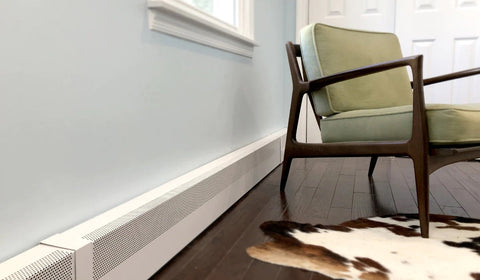Best Baseboard Heater Covers: Aluminum vs Plastic vs Steel Baseboard Heater Covers

If you’re looking to revamp your baseboard heaters and give them an updated look, replacing the covers is the simplest way to transform them from an eyesore to a seamless design element. As you weigh your options and consider the different colors and styles, you’ll no doubt run into the question of what material is best suited for a baseboard heater cover.
Generally, the three most common materials that make up baseboard heater covers are aluminum, steel, and plastic. Each of these materials has their own set of advantages and disadvantages, which make it even more difficult to choose.
By pondering the pros and cons of each material, you can select the most suitable option for your needs and personal taste. Let’s explore qualities like durability, weight, and aesthetics of aluminum, steel, and plastic baseboard heater covers to help you make an informed final decision.

1. Aluminum Baseboard Heater Covers
Aluminum is a silvery-white metal, the thirteenth element in the periodic table. Known for its pliable nature and versatility, it serves many purposes from packaging to baseboard heater covers. Let’s check out the main pros and cons of covers made from this material.
Pros
- Durability - Aluminum naturally forms a protective oxide layer, providing resistance against corrosion and rust. This means the material has a long lifespan, bolstering the overall durability of your heater covers.
- Easy installation - Aluminum is a lightweight material, making it easy to handle during installation, as well as easy to replace, adjust, and clean.
- Heat transfer - This material has excellent heat transferring capabilities, ensuring efficient heat distribution throughout a space.
Cons
- Strength - While aluminum is durable, it is not as strong as other materials like steel and may be prone to signs of wear and tear, like dents or scratches.
- Limited color choice - Aluminum baseboard heater covers come in limited colors, which restricts customization possibilities.
- Heat Transfer - Since aluminum is a good conductor of heat, the cover can become hot and pose a risk to children and pets. The proper distance between the heater and furniture or drapes must be maintained to ensure safety.
 2. Steel Baseboard Heater Covers
2. Steel Baseboard Heater Covers
Steel is an alloy of carbon and iron that is arguably the world’s most important engineering and construction material. This is because it is an indelibly strong material and is also highly recyclable, meaning it is beneficial for sustainable efforts. Learn more about the pros and cons of steel below.
Pros
- Durability - Steel is an extremely robust material that can withstand heavy usage and resist impacts, making it ideal for high-traffic areas.
- Aesthetics - Steel covers often have a sleek and modern appearance, offering a clean and polished look that many homeowners desire.
- Customization - Steel can be easily painted or powder-coated, which means it will be easy to match your baseboard covers to any interior style or color palette.
- Rust-Resistance - When a steel baseboard heater cover is powder coated (like Baseboarders), it becomes rust resistant. This makes it ideal for delaying the onset of rust in humid climates.
Cons
- Corrosion: Steel is susceptible to rust and corrosion in damp environments, but this can be prevented with regular maintenance and protective coating such as powder coating.
- Weight: Steel tends to be heavier than aluminum and plastic, which can potentially make installation more challenging.
- Higher cost: Compared to aluminum and plastic, steel baseboard heater covers are slightly more expensive.
 3. Plastic Baseboard Heater Covers
3. Plastic Baseboard Heater Covers
Last but not least is plastic. Plastic is a synthetic material made from polymers, which can be readily formed and shaped into various solid objects. Plastic is known for its wide range of properties. Though it’s not a good thing for the environment, plastic is nonetheless one of the most commonly used materials in the world. Here are the pros and cons of plastic baseboard heater covers.
Pros
- Design flexibility - Plastic is unique in that it can be molded into various shapes and sizes, offering added versatility in design.
- Easy installation - Like aluminum, plastic is lightweight and therefore easy to handle during installation.
- Cost effective - Plastic covers are generally the most inexpensive of any material, making them an incredibly budget-friendly option.
Cons
- Durability - While plastic covers can be durable, they may be susceptible to cracks and breakages over time, especially in high-traffic areas. Plastic covers can also begin to lose their shape when exposed to heat.
- Heat transfer - Plastic has lower heat transfer capabilities compared to other materials, potentially reducing the efficiency of your heating system.
- Aesthetics - Plastic covers may not provide the same level of visual appeal as aluminum or steel, lacking a premium aesthetic.
What about wood? See how wood heater covers compare.
Now that you’re armed with the facts about aluminum vs plastic vs steel baseboard vent covers, start shopping for the best baseboard heater covers on the market.
